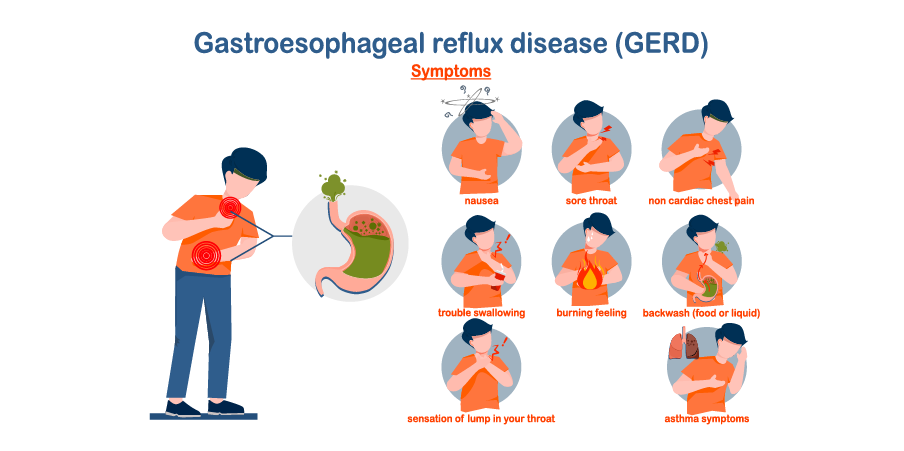Nội dung của trang này:
Nội dung của trang này:
Clinical Presentation
The typical symptoms are heartburn and acid regurgitation. Heartburn is the burning sensation in the retrosternal region, while acid regurgitation is the perception of the flow of refluxed gastric contents into the mouth or hypopharynx. Other presenting symptoms include nausea, chest pain, epigastric pain, belching, early satiety, and bloating. Non-cardiac chest pain (NCCP) is common among Asian patients and may be a presenting feature of gastroesophageal reflux disease.
Tiền sử bệnh
Clinical Diagnosis
History
Since gastroesophageal reflux disease occurs with few, if any, abnormal physical findings, a well-taken history is essential in establishing the diagnosis of gastroesophageal reflux disease. The manifestations of gastroesophageal reflux disease present in a number of ways:
A. Based on Symptomatology
 Gastroesophageal Reflux Disease_Initial Assesment
Gastroesophageal Reflux Disease_Initial Assesment
This classification allows symptoms to define the disease. The manifestations of gastroesophageal reflux disease are divided into esophageal and extraesophageal syndromes.
1. Esophageal Syndromes are characterized by the constellation of symptoms that may or may not be defined by further diagnostic tests. Esophageal symptomatic syndromes refer to uninvestigated patients with esophageal symptoms but without evidence of esophageal injury. These include the typical reflux syndrome defined by the presence of troublesome heartburn and/or acid regurgitation which are characteristic symptoms of gastroesophageal reflux disease, and an office diagnosis of gastroesophageal reflux disease may be made when these symptoms are present. Typical reflux syndrome can often be diagnosed without diagnostic testing; however, alarm symptoms should be excluded first.
Alarm symptoms are features that strongly raise suspicion of a complication or a malignancy. These include gastrointestinal (GI) bleeding, anemia, abdominal mass, unexplained weight loss, vomiting, progressive dysphagia, odynophagia, persistent pain, lymphadenopathy, family history of esophageal or gastric adenocarcinoma, dysphonia, recurrent cough or bronchial symptoms, and onset of symptoms at 45-55 years old (lower in Asian regions). These have low predictive value and suggest advanced, rather than early, malignancy. In the Asia-Pacific region, patients with alarm symptoms are likely to have gastric than esophageal cancer due to the higher prevalence of peptic ulcer disease and gastric cancer in this region. Their role as a diagnostic tool has limited evidence but individual alarm features with the best performance for identifying esophageal or gastric malignancies are weight loss, dysphagia, and epigastric mass on examination. Esophageal syndromes with esophageal injury include patients with demonstrable esophageal injury (eg reflux esophagitis, stricture, Barrett’s esophagus, adenocarcinoma).
2. Extraesophageal Syndromes with Established Associations are defined by conditions with an established association with gastroesophageal reflux disease based on population-based studies. Examples are reflux cough syndrome, reflux asthma syndrome, reflux laryngitis syndrome, and reflux dental erosion syndrome. It is rare for extraesophageal syndromes to occur alone without a concomitant manifestation of typical esophageal syndrome. These syndromes are usually multifactorial, with gastroesophageal reflux disease as only one of the many other potential aggravating factors.
3. Extraesophageal Syndromes with Proposed Associations are defined by conditions whose causal associations with gastroesophageal reflux disease are unclear or lacking evidence. Examples are sinusitis, pharyngitis, recurrent otitis media, and pulmonary fibrosis.
B. Based on Endoscopic Findings
1. Erosive Reflux Disease (ERD)
Erosive reflux disease is defined by the presence of esophageal mucosal damage. Examples are erosive esophagitis and Barrett’s esophagus.
2. Non-erosive Reflux Disease (NERD)
Non-erosive reflux disease is defined by the absence of esophageal mucosal damage (endoscopy-negative reflux disease) in the presence of troublesome reflux-associated symptoms without recent acid-suppressive therapy. This is more common in Asia.
Precipitating Factors
The precipitating factors are coffee, chocolate, fatty foods, and acidic foods (eg spicy foods, citrus, carbonated drinks).
Medication History
A number of common drugs and hormonal products have been associated with gastroesophageal reflux disease. Examples are anticholinergics, benzodiazepines, calcium channel blockers, Dopamine, nicotine, nitrates, Theophylline, Estrogens, Progesterone, Glucagon, some prostaglandins, and nonsteroidal anti-inflammatory drugs (NSAIDs), bisphosphonates, and antibiotics.
Khám thực thể
Typically, the physical examination findings are normal. Alarm features that are atypical in gastroesophageal reflux disease may include lymphadenopathy, epigastric mass, or signs of anemia.
